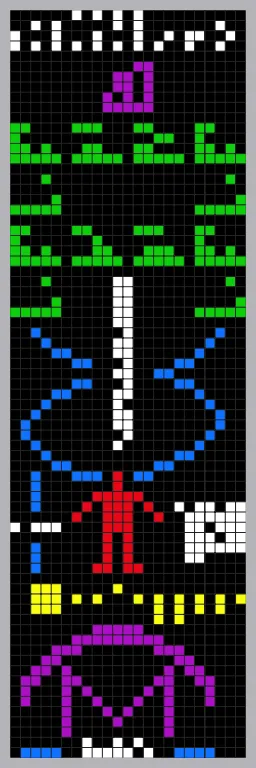The first attempt to design a message for an extraterrestrials intelligence was, to put it bluntly, a total failure. In 1960, the planetary astronomer Frank Drake conducted the first search for extraterrestrial intelligence from the radio astronomy observatory in Green Bank, West Virginia. Known as Project Ozma, Drake spent several hours per day over the course of four months listening to two nearby stars for signs of intelligent life.
By the time Drake pulled the plug on Project Ozma, he had yet to detect any evidence that there was life around his stellar targets. In retrospect, discovering life around these stars would have been a remarkable coincidence, but Drake’s fruitless search raised serious questions about the future of the search for extraterrestrial intelligence - or whether the search had any future at all.
In the wake of Project Ozma, Drake organised a conference at Green Bank and invited a handful of leading American scientists from a diverse range of fields to discuss the search for extraterrestrial intelligence or SETI. Among the attendees was the young planetary scientist Carl Sagan; Otto Struve, the director of the Green Bank observatory and among the first to try to estimate the prevalence of extraterrestrial life; the inventor Barney Oliver, who would later author NASA’s first report on SETI; and the chemist Melvin Calvin, who would be notified that he had won a Nobel Prize during the course of the three-day conference.
Read more about extraterrestrial communication:
- First contact: what if we find alien life?
- Alien contact: Brits pick scientists over politicians for first contact
- How could we talk fluently to aliens?
The Green Bank summit was a landmark event in the history of SETI and would determine its research directions for decades to come. One of the most notable products of the meeting is the well-known Drake equation, which can be used to estimate the probability of intelligent life in the Universe. But in the months following the historic meeting, Drake realised that if SETI were successful and detected a signal from outer space, this would raise a serious issue that had been neglected at the conference: how to design a response.
So Drake set about designing an experimental interstellar message with the intention of sending it to the Green Bank attendees as a test. The message consisted of a string of 551 binary digits that could be arranged so that their bit values formed pictures. The number 551 is semiprime, a design feature that Drake hoped wouldn’t escape the notice of an extraterrestrial - or his human test subjects.
The number served as an instruction manual for how to arrange the string of bits so that it formed a 19 x 29 array and revealed the pictures contained in the messages. These pictures depicted things like numbers and a human figure, but many of the images required a great deal of imaginative interpretation. But if anyone could decipher the code, Drake assumed it would be the nine individuals who had given the most thought to the challenges of extraterrestrial communication.

So Drake sent his prototype interstellar message by post to the Green Bank attendees with a short introduction: “Here is a hypothetical message received from outer space. It contains 551 zeros and ones. What does it mean?”
Drake received only a single reply to his prototype interstellar message. It was from Barney Oliver, the director of Hewlett Packard Labs, who responded with his own semiprime binary string. When Drake translated Oliver’s reply into a bit-array, he found that it contained a “simple and inspiring” message: a picture of a martini glass with an olive in it. Although Oliver had understood the format of Drake’s message, he had failed to interpret even the simple numbering scheme.
The inability of the Green Bank attendees to decipher Drake’s experimental interstellar message was not for want of intellect, however. Drake later sent the message to a few Nobel laureates, all of whom either failed to decipher it at all or arrived at incorrect interpretations. One physicist, for example, interpreted the binary string as a close approximation of the quantum numbers that describe the position of electrons in an iron atom. It was only when Drake submitted the message to a magazine for amateur codebreakers that an electrical engineer in Brooklyn wrote to him and demonstrated that he had correctly deciphered most of the message.
Given the difficulty that some of the brightest Earthlings encountered when trying to decipher Drake’s message, it seems unlikely that an extraterrestrial intelligence would fare any better. Drake’s failed experiment remains an instructive example for those attempting to design interstellar messages insofar as it calls attention to the multitude of latent conventions that haunt human cognition and communication. Although Drake’s prototype message did serve as the basis for the first message broadcast into space from the Arecibo radio telescope in 1974, the designs of subsequent interstellar messages were far more sophisticated.

Around the same time that Drake was hashing out the details of Project Ozma, a Dutch mathematician named Hans Freudenthal was also consumed by the problem of interstellar communication. In 1960, Freudenthal published Lingua Cosmica: Design of a Language for Cosmic Intercourse, which is widely regarded as the first language designed specifically for extraterrestrial communication.
Unlike Drake’s iconic message, Freudenthal’s system, known as Lincos, was largely symbolic. The language was based on a foundation of formal logic and basic arithmetic that Freudenthal demonstrated could be used to discuss everything from basic scientific facts to the nuances of human social norms.
The design of Lincos grew directly from Freudenthal’s approach to mathematical pedagogy on Earth. A vehement opponent of the so-called “new math,” an approach to mathematical education that produced students who could recite formulas without knowing what they were good for, Freudenthal instead advocated for a mathematics syllabus grounded in everyday experience. As such, Freudenthal’s interstellar communication system eschewed complete formalization and instead sought to approximate natural language and teach extraterrestrials by way of example.
Read more about alien life:
- The thought experiment: What would happen if aliens contacted us?
- Alien invasion (of sorts)! 10 of the friendliest aliens in film
- It Came from Beyond the Silver Screen! Aliens in the Movies
Freudenthal didn’t live to see Lincos transmitted into space, but his extraterrestrial language was used as the basis for two messages broadcast to the cosmos around the new millennium. Known as the Cosmic Call messages, these transmissions were sent to a handful of stellar targets in 1999 and 2003.
At the core of these transmissions is a linguistic system designed by Yvan Dutil and Stephane Dumas, two physicists who were interested in the possibility of extraterrestrial life. Their message was derived from Lincos and consisted of dozens of unique characters represented as bit images. The Cosmic Call messages used these characters to introduce numerals before proceeding to more complex topics like scientific facts about Earth and other planets in our Solar System.
For all the ingenuity of Freudenthal’s Lincos, his attempt to approximate the casualness of natural language resulted in a complicated and unwieldy communication system. When it comes to interstellar messages, it’s best to keep things as simple as possible so that the message has a better chance of being understood by an extraterrestrial recipient. In this respect, the second generation of the lingua cosmica, recently developed by the Dutch astronomer and computer scientist Alexander Ollongren, is a marked improvement.
There are 100 billion stars in our Galaxy – surely we can’t be the only intelligent lifeform out there? In this Science Focus Podcast we ask Mike Garrett what we’ll do if we find them, and what it means for us as humans
If Freudenthal’s Lincos marked the “symbolic turn” in the design of interstellar messages, which had previously been almost entirely based on icons and images, Ollongren might be said to be the progenitor of computational interstellar messages.
Lincos 2.0, which Ollongren describes at length in his 2013 book, Astrolinguistics, is based on the lambda calculus and the calculus of constructions with induction. These two systems of formal logic were at the heart of the computer revolution on Earth, and while they sound complicated, they stand to lend a great deal of clarity to extraterrestrial messages.
The lambda calculus, for example, is a logical system that is able to describe any number of relations between objects using only a handful of symbols. To describe complex relationships between objects involves the combination of simple generalised declarations, rather than an entire language in which each object is given a unique name. The calculus of constructions with induction, meanwhile, allows mathematical statements to be proven within the system itself.
This is an invaluable design feature of an interstellar message since an extraterrestrial will be able to determine whether they have arrived at the correct interpretation of a message on its own without having to send a message to Earth and wait for a response.

Ollongren’s second-generation Lincos is best characterised as a meta-language for interstellar communication. The idea would be to send a message that consists of, say, a book written in natural language and to use Ollongren’s Lincos as a way to describe the contents of the book using formal logic. This approach would be especially useful if the extraterrestrial recipient is more machine than flesh since the logical systems at the root of Lincos 2.0 are also at the root of many coding languages on Earth.
These are but a few of the extraterrestrial languages that have been developed in the half-century since Drake first scanned the cosmos for signs of intelligent life. Until we receive an extraterrestrial message on Earth, each system for interstellar communication must be designed based on educated guesswork. Perhaps ET will be more inclined to respond to the musical messages we’ve sent into space rather than the messages based on logic.
Until we achieve first contact, we can’t know for certain what might be lurking in the cosmos. But as Drake’s early prototype serves to remind us, the design of extraterrestrial languages remains a fruitful area of research—if only for what it can teach us about ourselves.
This was adapted from Extraterrestrial Languages by Daniel Oberhaus, which is out now (£20, MIT Press)